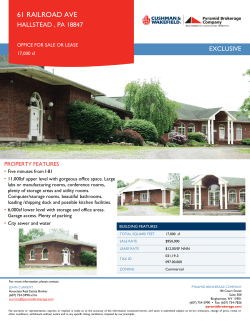
BancAnalysts Association of Boston Conference David Carroll Senior Executive Vice President
BancAnalysts Association of Boston Conference David Carroll Senior Executive Vice President Wealth, Brokerage & Retirement November 6, 2014 Agenda Wells Fargo Overview Wealth, Brokerage & Retirement (WBR) Update Key Opportunities 1 Wells Fargo vision Wells Fargo Vision “We want to satisfy all our customers’ financial needs and help them succeed financially.” 2 Wells Fargo’s model is based on sustainable long-term advantages Strong distribution Leading market share in key financial products Diversified and balanced revenue sources Large and low-cost deposit base Relationship focus and cross-sell capability Comprehensive risk discipline Capital strength Deep culture and the right team 3 Serving consumers and businesses in more communities than any other U.S. Bank 70+ MM customers 8,753 stores Store Distribution Retail banking 6,165 Wells Fargo Advisors 1,380 Wholesale 677 Mortgage 531 Sales Force Platform bankers Financial advisors Wells Fargo Advisors offices Wells Fargo Retail Banking stores Wells Fargo Home Mortgage stores (1) (2) Home Mortgage consultants 15,163 7,128 Other Distribution Channels ATMs 12,739 Online banking customers (3) As of September 30, 2014. (1) Active, full-time equivalent. (2) Series 7 brokers. (3) Regional banking online and mobile customers, based on 90-day active accounts, as of August 2014. 32,108 Mobile customers 24.4 MM (3) 13.7 MM 4 Strong 3Q14 results Wells Fargo Net Income Pre-tax Pre-provision Profit ($ in millions) 5,578 5,610 5,893 (1) ($ in millions) 5,726 5,729 $1.01 $1.02 2Q14 3Q14 8,580 8,677 8,872 8,965 8,376 3Q13 4Q13 1Q14 2Q14 3Q14 $1.05 $0.99 3Q13 $1.00 4Q13 1Q14 Diluted earnings per common share Earnings of $5.7 billion and EPS of $1.02, both up 3% year-over-year (YoY) Continued balance sheet strength: - Period-end loans up $29.7 billion, or 4% YoY - Period-end deposits up $88.8 billion, or 9% YoY - Credit continued to improve with net charge-offs of 32 bps Solid returns with an ROA of 1.40% and ROE of 13.10% Strong capital position and shareholder return (1) Pre-tax pre-provision profit (PTPP) is total revenue less noninterest expense. Management believes PTPP is a useful financial measure because it enables investors and others to assess the Company’s ability to generate capital to cover credit losses through a credit cycle. 5 Strong revenue diversification Balanced Spread and Fee Income 52% Net Interest Income $21.2 billion 48% Diversified Fee Generation Other noninterest income (1) Deposit service charges Net gains from equity investments 2% 7% 13% Net gains on debt securities Net gains from trading 2% 2% Insurance 4% Mortgage Orig./ Sales, net 9% Brokerage advisory, 23% commissions and other $10.3 billion Noninterest Income Mortgage Servicing, net 7% 2% All other fees 1% Letters of credit 2% 1% CRE brokerage commissions 3% 1% Cash network 8% 4% 9% Merchant processing Card fees Charges and fees on loans Trust and investment management Investment banking Insurance 4% Total Trust & Investment Fees 35% Net Gains from Trading 2% Card Fees Net Gains on Debt Securities 2% 7% Deposit Service Charges 13% 9% Total Other Fees 10% Net Gains from Equity Inv. Total Mortgage Banking 16% Other Noninterest Income (1) 2% All data is for 3Q14. (1) Other noninterest income includes lease income, life insurance investment income and all other noninterest income. 6 Agenda Wells Fargo Overview Wealth, Brokerage & Retirement (WBR) Update Key Opportunities 7 WBR business overview WBR offers a full range of financial advisory, lending, fiduciary and investment management services to clients using a planning approach Retail Brokerage Wealth Management Abbot Downing Retirement Serves mass, mass affluent, affluent and high net worth clients’ advisory, brokerage and financial needs through multiple channels Provides affluent and high net worth clients with a complete range of wealth management solutions, including financial planning, private banking, credit, investment management and fiduciary services Provides comprehensive wealth management services to ultra high net worth families and individuals as well as endowments and foundations Provides institutional retirement (IRT) and trust services (including 401(k) and pension plan record keeping) for businesses, retail retirement solutions for individuals, and reinsurance services for the life insurance industry 8 Size and scope Retail Brokerage Wealth Management Abbot Downing Client Assets $1.4T $180B $39B Clients 3.2MM Households 70K Relationships Over 600 Relationships Industry Rankings #3 U.S. Retail Brokerage firm (1) #3 Managed account provider (2) #4 Wealth Management firm (3) #8 Family Office Retirement IRA: $354B IRT: $314B 3.3MM Retail Retirement HHs (4) #2 Annuity Distributor (5) #6 IRA provider (6) #8 Institutional Retirement Plan Recordkeeper (7) Data as of 9/30/14, unless otherwise noted. Client counts not mutually exclusive. Assets include deposits. Households (HHs) defined as client accounts grouped based on address matching; Relationships represent clients grouped by relationship manager and may include multiple clients/accounts. (1) Source: Company data and peer analysis as of 9/30/14; based on FA counts. (2) Source: Cerulli Associates; based on 2Q14 Brokerage advisory assets (3) Source: Barron’s 2014 Survey; based on Assets Under Management in accounts > $5MM (as of Jun 30, 2014). Includes Brokerage Client Assets and Wealth Assets Under Management. (4) Source: Bloomberg Top 50 Family Offices; based on assets as of 12/31/12. (5) Source: 2014 Transamerica Roundtable Survey (April 2014), based on FY2013 sales. (6) Source: Cerulli Associates; based on 2Q14 assets. (7) Source: PLANSPONSOR Magazine (based on 4Q13 defined contribution assets), June 2014. 9 Channel diversity provides growth and choice Assets with us <$250K $250K-$1MM $1MM-$5MM $5MM-$50MM The Private Bank Wealth Brokerage Services MultiChannel Delivery Model >$50MM Abbot Downing Private Client Group (PCG) Phone Advisors FiNet Advisors, First Clearing, Mobile/Online Client Service Model Self Service Direct Personalized/local service Scalable solutions Personalized/local service Team of experts model Customized planning and solutions Cost-toServe Low Modest/flexible High 10 WBR revenue and earnings contribution WBR Share of WFC WBR Revenue by Category Revenue 83% WBR 17% Trust & Investment Fees 74% Earnings Other 4% 91% WBR 9% Net Interest Income 22% Data represents nine months ended September 30, 2014. 11 WBR financial performance Total Revenue ($ in billions) Net Income $13.2 $1.7 Up 28.5% $1.6 $1.3 $10.8 $8.4 $1.3 $1.2 $1.0 Up 8.3% $9.8 $10.6 $10.3 $7.6 $8.2 $2.4 $2.9 $2.1 $2.3 2009 2013 2013 YTD 2014 YTD Net Interest Income Noninterest Income Noninterest Expense $0.5 Up 3.8% $9.4 2009 2010 2011 2012 2013 2013 YTD $10.5 $7.8 $8.1 2013 YTD 2014 YTD 2014 YTD PTPP CAGR (2009-2013): 19.7% (1) 2009 2013 YTD data represents nine months ended September 30. (1) Pre-tax pre-provision profit (PTPP) is total revenue less noninterest expense. Management believes that PTPP is a useful financial measure because it enables investors and others to assess our ability to generate capital to cover credit losses through a credit cycle. 12 WBR performance measures Pre-tax Margin Operating Leverage 24% 21% 17% 4.5% 20% 18% 2.9% 2.1% 2.0% 0.3% 2011 2012 2013 2013 YTD 2014 YTD 2011 Net Interest Margin 1.93% 1.75% 1.65% 2012 2013 2012 1.63% 1.70% 2013 2013 YTD 2014 YTD Return on Equity 21.0% 19.2% 18.7% 2011 2013 YTD 2014 YTD 2011 2012 2013 20.0% 20.2% 2013 YTD 2014 YTD YTD data represents nine months ended September 30. 13 Growth in recurring revenue 2009 Revenue Mix 2013 Revenue Mix 2014 YTD Revenue Mix Recurring Revenue 65% Recurring Revenue 76% Recurring Revenue 80% 35% 55% 43% 22% Recurring Revenue: Asset Based / Other Recurring 20% 24% 58% 22% 22% Non-Recurring Revenue: Transactional / Other Non-Recurring Fees Net Interest Income YTD 2014 represents nine months ended September 30, 2014. 14 Growth in Brokerage advisory assets 3Q14 Brokerage Client Assets: $1.4T Advisory Assets: $0.4T 71% Other Brokerage Client Assets: $1.0T 29% Advisory Assets as a % of Total Brokerage Client Assets 18% 20% 23% 25% 27% 29% 2009 2010 2011 2012 2013 3Q14 15 Agenda Wells Fargo Overview Wealth, Brokerage & Retirement (WBR) Update Key Opportunities 16 One Wells Fargo Business Banking Wholesale Banking IntraIntraDivision Partners Division Partners Mortgage Banking Community Banking 17 Capitalizing on strategic opportunities Accelerating Adoption of Best Practices 1) Advisor Best Practices 2) Community Bank Partnership Leveraging the Power of One Wells Fargo 3) Lending Opportunities 4) High Net Worth Partnership 18 Advisor Best Practices opportunity Adoption is measured by the degree to which advisors embrace proven strategies within their practice. Commitment to understanding clients’ personal and financial priorities Client Discovery EVOLVE Client Reviews Financial Strategies Action Plan Investments Protect Banking ADVISE Client Information Mgmt. Plan ANALYZE Solutions and relationship evolve as the client’s life changes Family, Occupation, Recreation, Money UNDERSTAND Access to a knowledgeable advisor and team of financial experts Recommended Advice Tailored advice that is aligned with the client’s circumstances Advisor adoption 3x higher over the last 4 years Clients are 30% more loyal when advisors use best practices Advisors (1) applying best practices grow production 2.5x greater (1) Advisor productivity growth includes producing FAs with the firm from 2009 – September 2014. 19 WBR/Community Bank partnership Growing the Affluent Opportunity Saving, Investing & Retirement Planning Dollars Held Away $2.1T Saving Investing & Retirement Planning Client Needs Clients with both bank and WBR relationships meet a greater number of financial needs with a deep relationship within those needs Client retention averages 98.5% (1) for clients with both bank and WBR relationships Client Profitability Clients with both bank and WBR products are over five times more profitable than bank only, and over two times more profitable than WBR only (2) Brokerage Client Assets Total Brokerage client assets up 25% since 2011 - Bank/Brokerage client assets up 35% Bank/Brokerage client asset share increased from 33% in 2011 to 36% in 3Q14 Investment assets referred to Brokerage up 31% CAGR since 2011 - Over $1.0 billion a month in investment assets referred (1) Client retention averages represent rolling two-year averages through September 2014. (2) Relative client profitability as of September 2014 (annualized profit). 20 Growth in outstanding loans Growth Highlights WBR Loans (Average balances, $ in billions) Driven by growth in high-quality, nonconforming (i.e. jumbo) mortgage loans and securities-based lending Other revolving credit primarily consists of securities-based lending, including margin loans, secured prime lines, custom lines of credit and priority credit lines FA loan origination participation remains strong through September 2014 $51.2 $46.1 $42.7 $13.2 $12.1 $11.0 $13.1 $13.0 $13.1 - Over 60% of FA’s participating in loan originations Partnership Opportunity for Home Lending and WBR (1) $18.7 2012 $20.9 2013 Consumer Real Estate Other Revolving Credit $24.9 Home Lending provides financing to 3.7 million affluent households (2), but only 11% work with Wells Fargo for planning, investing and retirement needs 2014 YTD Over 2 million WBR clients hold a U.S. residential mortgage, but only 29% have their mortgage with Wells Fargo Commercial Loans (1) As of 12/31/2013. (2) Affluent are WF Home Lending households (HHs) with total Wells Fargo combined deposit and investment balances greater than $100K or total deposit and investment balances of $100K. 21 Expanding the High Net Worth partnership Early successes in the partnership led to expanding the client profile threshold to $2.5MM AUM from $5MM+, increasing our opportunity to satisfy High Net Worth clients’ complex financial needs Qualified HHs Original Opportunity Increased Opportunity 13,000 HHs with $5MM+ AUM Over 50,000 HHs with $2.5MM+ AUM Client Assets HHs hold > $150B AUM HHs hold > $300B AUM FA's with qualified HHs ~5,800 ~8,200 ~500 FAs ~900 FAs Financial Advisor Participation $5.3 Billion in Client Balances $2.2 $1.7 $1.4 Balances as of 9/30/14 Credit Balances Brokerage Assets Trust Assets 22 WBR is well positioned for the future Focusing on execution, while capitalizing on opportunities, has resulted in strong performance - Continue to enhance recurring revenue contribution with 2014 YTD improving to 80% from 65% in 2011 - Emphasis on pre-tax margin expansion, improving 694 bps from 2011 to 24% in 2014 YTD - 4-year WBR segment PTPP CAGR of 19.7% Wells Fargo’s culture and tenure of the team is a competitive differentiator Strategic initiatives remain similar with those shared at the 2012 Investor Day, yet refinements and enhancements have contributed to additional traction and success “One Wells Fargo” is a sustainable long-term advantage 23 24 Forward-looking statements and additional information Forward-looking statements: This document contains “forward-looking statements” within the meaning of the Private Securities Litigation Reform Act of 1995. In addition, we may make forward-looking statements in our other documents filed or furnished with the SEC, and our management may make forwardlooking statements orally to analysts, investors, representatives of the media and others. Forward-looking statements can be identified by words such as “anticipates,” “intends,” “plans,” “seeks,” “believes,” “estimates,” “expects,” “target,” “projects,” “outlook,” “forecast,” “will,” “may,” “could,” “should,” “can” and similar references to future periods. In particular, forward-looking statements include, but are not limited to, statements we make about: (i) the future operating or financial performance of the Company, including our outlook for future growth; (ii) our noninterest expense and efficiency ratio; (iii) future credit quality and performance, including our expectations regarding future loan losses and allowance releases; (iv) the appropriateness of the allowance for credit losses; (v) our expectations regarding net interest income and net interest margin; (vi) loan growth or the reduction or mitigation of risk in our loan portfolios; (vii) future capital levels and our estimated Common Equity Tier 1 ratio under Basel III capital standards; (viii) the performance of our mortgage business and any related exposures; (ix) the expected outcome and impact of legal, regulatory and legislative developments, as well as our expectations regarding compliance therewith; (x) future common stock dividends, common share repurchases and other uses of capital; (xi) our targeted range for return on assets and return on equity; (xii) the outcome of contingencies, such as legal proceedings; and (xiii) the Company’s plans, objectives and strategies. Forward-looking statements are not based on historical facts but instead represent our current expectations and assumptions regarding our business, the economy and other future conditions. Investors are urged to not unduly rely on forwardlooking statements as actual results could differ materially from expectations. Forward-looking statements speak only as of the date made, and we do not undertake to update them to reflect changes or events that occur after that date. For more information about factors that could cause actual results to differ materially from expectations, refer to the “Forward-Looking Statements” discussion in Wells Fargo’s press release announcing our third quarter 2014 results and in our most recent Quarterly Report on Form 10-Q, as well as to Wells Fargo’s other reports filed with the Securities and Exchange Commission, including the discussion under “Risk Factors” in our Annual Report on Form 10-K for the year ended December 31, 2013. Purchased credit-impaired loan portfolio: Loans that were acquired from Wachovia that were considered credit impaired were written down at acquisition date in purchase accounting to an amount estimated to be collectible and the related allowance for loan losses was not carried over to Wells Fargo’s allowance. In addition, such purchased credit-impaired loans are not classified as nonaccrual or nonperforming, and are not included in loans that were contractually 90+ days past due and still accruing. Any losses on such loans are charged against the nonaccretable difference established in purchase accounting and are not reported as charge-offs (until such difference is fully utilized). As a result of accounting for purchased loans with evidence of credit deterioration, certain ratios of the combined company are not comparable to a portfolio that does not include purchased credit-impaired loans. In certain cases, the purchased credit-impaired loans may affect portfolio credit ratios and trends. Management believes that the presentation of information adjusted to exclude the purchased credit-impaired loans provides useful disclosure regarding the credit quality of the non-impaired loan portfolio. Accordingly, certain of the loan balances and credit ratios in this document have been adjusted to exclude the purchased credit-impaired loans. References in this document to impaired loans mean the purchased credit-impaired loans. Please see pages 32-34 of the press release announcing our 3Q14 results for additional information regarding the purchased credit-impaired loans. 25
© Copyright 2025









